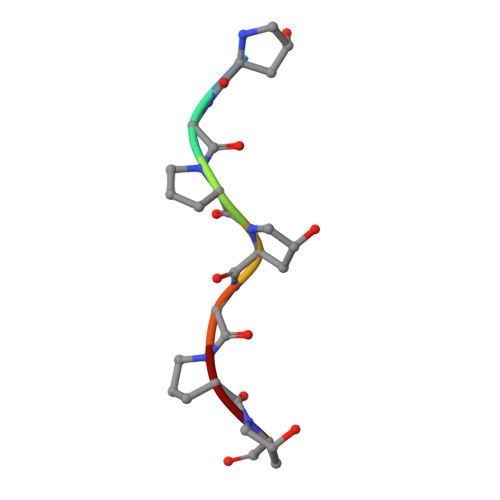Crystal structures of collagen model peptides with Pro-Hyp-Gly repeating sequence at 1.26 A resolution: implications for proline ring puckering
Okuyama, K., Hongo, C., Fukushima, R., Wu, G., Narita, H., Noguchi, K., Tanaka, Y., Nishino, N.(2004) Biopolymers 76: 367-377
- PubMed: 15386273
- DOI: https://doi.org/10.1002/bip.20107
- Primary Citation of Related Structures:
1V4F, 1V6Q, 1V7H - PubMed Abstract:
Triple-helical structures of (Pro-Hyp-Gly)n (n = 10, 11) at 100 K and room temperature (RT) were analyzed at 1.26 A resolution by using synchrotron radiation data. Totals of 49 and 42 water molecules per seven triplets in an asymmetric unit were found for the structures at 100 K and RT, respectively. These water molecules were classified into two groups, those in the first and second hydration shells. Although there was no significant difference between water molecules in the first shell at 100 K and those at RT, a significant difference between those in the second shell was observed. That is, the number of water molecules at RT decreased to one half and the average distance from peptide chains at RT became longer by about 0.3 A. On the other hand, of seven triplets in an asymmetric unit, three proline residues at the X position at 100 K clearly showed an up-puckering conformation, as opposed to the recent propensity-based hypothesis for the stabilization and destabilization of triple-helical structures by proline hydroxylation. This puckering was attributed to the interaction between proline rings and the surrounding water molecules at 100 K, which is much weaker at RT, as shown by longer average distance from peptide chains.
- Faculty of Technology, Tokyo University of Agriculture and Technology, Koganei, Tokyo 184-8588, Japan. okuyamak@cc.tuat.ac.jp
Organizational Affiliation:



















